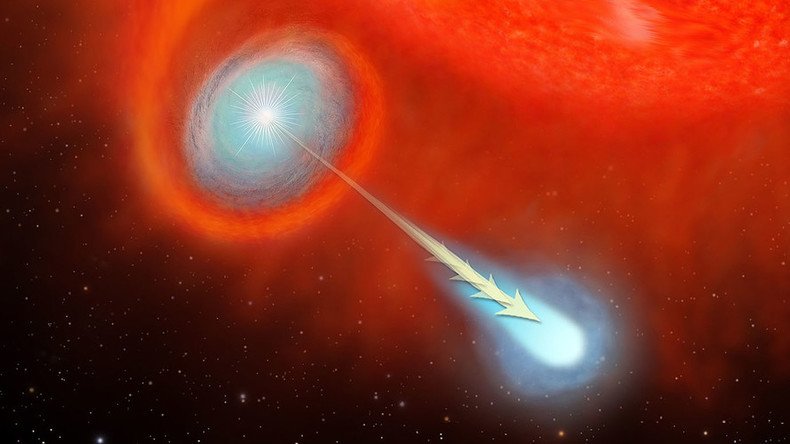Twice as big as Mars: Hubble spots molten ‘cannonballs’ blasting through space (IMAGES)

Enormous balls of molten plasma are flying through space so fast that they could travel from Earth to the moon in 30 minutes. Luckily for us, they’re some 1,200 light years away from our planet.
The NASA/ESA Hubble Space Telescope detected the incredibly-hot blobs of gas being ejected near a dying star called V Hydrae - a bloated red giant continually shedding its mass as it dies.
READ MORE: NASA cuts live feed from ISS after ‘UFO’ spotted (VIDEO)
A research team at NASA's Jet Propulsion Laboratory in California used Hubble to observe V Hydrae and its surrounding region over an 11-year period, and have now published details of their study in The Astrophysical Journal.
The data showed a string of monstrous fiery blobs, each with a temperature almost twice that of the sun’s surface. The blobs are not simply fired in the same direction every time, but switch direction slightly between emissions, according to researcher Raghvendra Sahai.
However, scientists are still struggling to explain the origin of the fireballs as, according to NASA, they could not have been shot out by the deteriorating star. One theory is that they were launched by an as-yet unseen companion star which is in an egg-shaped orbit around the red giant.
Astronomers believe the fiery spheres, each twice the size of Mars, are the latest in a continuous stream of stellar "cannon fire" which has happened every 8-and-a-half years for at least the past four centuries.
Hubble has detected superhot blobs of gas, each twice as massive as Mars, being ejected near a dying star!
— Hubble (@NASA_Hubble) October 6, 2016
READ: https://t.co/vvzL2x8duPpic.twitter.com/vmacApMajg
It’s thought that a companion star passes by V Hydrae every several years and sucks up material from the atmosphere before cannoning lumps of it into space at colossal speeds of up to 500,000 miles an hour.
The researchers say this star system could help explain the dazzling variety of intriguing glowing shapes that Hubble has seen around dying stars.
Happy #WorldSpaceWeek!! The Antennae Galaxies in this image are the nearest and youngest examples of a pair of colliding galaxies. pic.twitter.com/C4bofYbKfD
— Hubble (@NASA_Hubble) October 5, 2016
The Hubble Space Telescope has now been in service for 26 years and, over that time, has found evidence of numerous stunning stellar activities, including colliding galaxies and exoplanets ‘bleeding off’ streams of hydrogen.
It also holds the record for finding the farthest exoplanets discovered to date.
M10 | Globular Cluster
— Learn to Skywatch (@Learntoskywatch) October 5, 2016
Sits right in the center of Ophiuchus
Bright enough to be seen in binoculars
But very small! Just 3.9'
Image: Hubble pic.twitter.com/2IlLv6ODmq
Hubble Reveals Ghostly Core of the Supernova Seen by Chinese Astronomers in 1054 https://t.co/QtvH1fEA2epic.twitter.com/AZtbLYh7FA
— The Daily Galaxy (@dailygalaxy) October 3, 2016












